Before Anderson Cooper, it was Bernard Shaw. Before Katrina, it was Baghdad ‘91
Those times were different. No Internet. No MS Windows, mostly typewriters. No digital cameras. Analog forced you to be more creative, more resourceful, and ingenious. If you were lucky you could wire your story or if available, fax it. Then someone in the newsroom would copy it into the system. For video you needed to work with local stations with satellite uplinks. If not, pray for UPS, FedEx and the airlines to transport the visual material. If lucky, immediately was a 24 hours thing. Now everyone takes a picture with a camera phone and seconds away it is all over the world. Back in the early ‘90s if you were working with color film you could expect photojournalists to develop their films in the water tanks of their toilet at their hotel rooms. So glam!
I was just a baby when the Vietnam War ended. I have no memories of it. And my war references where only stock, archival photos and videos or documentaries. But on January 16 , 1991 the Boys from Baghdad changed it. I remember sitting on the floor of the newsroom at awe watching for the first time a Live Coverage of a War. Billions of people turned into CNN to know what was happening in Baghdad. Right then, CNN single handily changed the news industry, and the war was right there in your living room for the very first time. No one had ever covered a war live from behind enemy lines as it happened. Bernard Shaw, Peter Arnett and the late John Holliman became our eyes and ears. First hand witness of the Bush administration “surgical bombings” over the city.
A certain déjà vu
 This weekend technology betrayed me. But in a leap of faith, I catch a movie I always recommend to my students: Live from Baghdad. It is based on CNN’s breakthrough coverage of First Gulf War or commonly known as Operation Desert Storm. That movie always takes me back to the early 1990’s. And it is a quite accurate of the things that goes behind the scenes of what you watch on the news in your TV set. But it also saddened me to recognize how the edge or hunger for news innovation that that generation had, has diminished trough the years. News people have softened their voices afraid to loose their access to official sources. And those who were brave enough to face authorities, like Anna Politkovskaya, are silenced by cowards.
This weekend technology betrayed me. But in a leap of faith, I catch a movie I always recommend to my students: Live from Baghdad. It is based on CNN’s breakthrough coverage of First Gulf War or commonly known as Operation Desert Storm. That movie always takes me back to the early 1990’s. And it is a quite accurate of the things that goes behind the scenes of what you watch on the news in your TV set. But it also saddened me to recognize how the edge or hunger for news innovation that that generation had, has diminished trough the years. News people have softened their voices afraid to loose their access to official sources. And those who were brave enough to face authorities, like Anna Politkovskaya, are silenced by cowards. The movie Live From Baghdad is a recreation of what happened in the Suite 906 of the Al-Rasheed hotel. Thanks to a “four wire” transmitter CNN was able to transmit during the siege of Baghdad. The official synopsis states that this production mixes breakneck excitement, biting humor and blistering drama in telling the behind-the-scenes true story of how brash CNN producer Robert Wiener (Michael Keaton) and his resourceful team made history, and reported it, during the onset of the 1991 Gulf War. Arriving in Baghdad, Wiener and co-producer Ingrid Formanek (Helena Bonham Carter) contend with numerous logistical, technical and political challenges as they attempt to report on the situation in Baghdad as war looms. While feeding stories to a hungry 24-hour news network under the scrutiny of Iraqi censorship and Saddam's propaganda efforts, the two producers must stay ahead of the competition - the Big Three networks. When the bombs hit Baghdad on January 16, 1991 (most of the other news crews have fled the city), the ingenuity and courage of Wiener, Ingrid and their crew (including CNN anchor Bernard Shaw and reporters Peter Arnett and John Holliman) pay off when they are able to use a coveted "four-wire" transmitter to relay live reports on the U.S. bombing of Baghdad not just to America, but the entire world.
Michael Keaton and CNN Producer Robert Weiner
 But Formanek says that what is most important to her is maintaining integrity, and resisting the trend of what she calls "more style than substance" in the media. She believes that the American media she so admired as child is in peril.
But Formanek says that what is most important to her is maintaining integrity, and resisting the trend of what she calls "more style than substance" in the media. She believes that the American media she so admired as child is in peril."I don't know if it's post-9/11 or a new patriotism or a fear of being seen as anti-American after President Bush's famous words 'You're either with us or against us,'" she says, "but I think we need to question actions and policies as much as we did before and keep governments honest."
She points to the trend among American journalists to say "we" instead of "the Bush administration" in statements such as, "We are bombing Iraq," as well as the tendency of news anchors and reporters to wear American flag pins on their lapels. She says these actions makes the jobs of foreign correspondents ever more dangerous and threatens reporters' credibility among foreign governments to tell the whole, unbiased story.
"People in the news business are buying into the government PR line," she says. "It's a trend that we are seeing and we have an obligation to fight it."
CNN Photog Saves Lives Following Hurricane
Source: Associated Press David Bauder writes: "Journalism may be the only profession where someone who helped save more than a dozen lives felt compelled to reassure his bosses that his time was well spent.The night after Hurricane Katrina struck, veteran CNN photographer Mark Biello brought back vivid images of New Orleans residents rescued from floodwaters that chased them to roofs or attics. Some he pulled into a boat himself.Biello isn't used to putting his camera down - journalists are trained to be observers, not participants. But the human misery caused by Katrina put these instincts at war with reality, and made many journalists rethink how to do their jobs amid calamities.
 After riding out the storm in a French Quarter hotel, Biello met CNN correspondent Jeanne Meserve at the Superdome. A distraught city councilman drove up and said his Ninth Ward neighborhood was submerged. The CNN team jumped in their car and followed him there.Biello, 44, has worked for CNN since 1983 and been to 81 countries, recording famine, disaster and the bombs that flew over Baghdad in the first Gulf War. But even he was shocked by what he saw from a New Orleans highway overpass."We did not know the extent of how many people were trapped," he said. "Nobody did ... As far as we could see in all directions you could hear people screaming and yelling, waving, some were drowning."Three men pulled up in a boat. Biello asked if he could come along.Their first rescue was a husband and wife plucked from a roof, arguing with each other as they stepped onto the boat."I was just recording and witnessing what they were doing," he said. "It wasn't until there were people submerged in the water that they asked for my help in pulling people onto the boat ... they needed the physical strength to pull people up." The filthy New Orleans water gave Biello a serious chest infection. But he was back in Louisiana for Hurricane Rita.
After riding out the storm in a French Quarter hotel, Biello met CNN correspondent Jeanne Meserve at the Superdome. A distraught city councilman drove up and said his Ninth Ward neighborhood was submerged. The CNN team jumped in their car and followed him there.Biello, 44, has worked for CNN since 1983 and been to 81 countries, recording famine, disaster and the bombs that flew over Baghdad in the first Gulf War. But even he was shocked by what he saw from a New Orleans highway overpass."We did not know the extent of how many people were trapped," he said. "Nobody did ... As far as we could see in all directions you could hear people screaming and yelling, waving, some were drowning."Three men pulled up in a boat. Biello asked if he could come along.Their first rescue was a husband and wife plucked from a roof, arguing with each other as they stepped onto the boat."I was just recording and witnessing what they were doing," he said. "It wasn't until there were people submerged in the water that they asked for my help in pulling people onto the boat ... they needed the physical strength to pull people up." The filthy New Orleans water gave Biello a serious chest infection. But he was back in Louisiana for Hurricane Rita. Bernard Shaw and Tom Johnson
January 1991, Shaw stayed behind -- with Peter Arnett and the late John Holliman -- after other Western reporters had deserted the city. As bombs rained down on the city outside their hotel window, the three, reporting by phone, coolly brought those images into living rooms across the world during the first attacks of the Persian Gulf War.
"All kinds of ordnance was being dropped, all kinds of bombs, and I made my peace with myself that I could die at any moment," Shaw told CNN recently. "We knew the dangers around us. I always believed that two major forces -- one of them supreme -- saved us that night: God and some extremely well trained and well disciplined American pilots."
Throughout his career, Shaw -- a history major in college -- was often an eyewitness to some of the biggest events of the last quarter-century, a position he did not take lightly.
"Whenever I found myself with a box seat on a historic story, the one thing I always strove to do was realize I had a responsibility ... It made me focus even more on the disciplines of journalism -- being fair, being accurate." "[You also need to have] regard for viewers, listeners and readers," he continued. "If people are depending on you, if you are the only source of accurate information, you have a dreadful responsibility. I say dreadful because it's so awesome."Shaw went on to become a household name with his reports from Baghdad, Iraq, in 1991 at the start of the Persian Gulf War. As bombs exploded outside his hotel window, Shaw coolly brought those images into living rooms across the world.
In 1990, Roth served as CNN's correspondent at the opening of the Berlin Wall and the overthrow of the communist governments in Czechoslovakia and Romania. In 1989, he covered the Beijing student uprising in Tiananmen Square and the ensuing Chinese government crackdown. Roth also has covered the terrorist attacks on the Achille Lauro cruise ship and at the Leonardo DaVinci Airport in Rome, both in 1985. He reported on the 1980 Winter Olympics in Lake Placid, N.Y., as well as the 1980 Democratic National Convention in New York.
Roth joined CNN when it launched in 1980 as an assignment desk editor in the network's New York bureau. He served as CNN's New York assistant bureau chief in 1981, the Chicago bureau chief in 1982 and the Rome bureau chief from 1982-1986. Before joining CNN, Roth worked as an anchor and reporter for AP Radio and as a producer for WPIX-TV in New York.
Last summer the Pentagon, backed by retired military brass, prominent political figures and associations of special forces veterans, began a campaign to drive him off of the air waves. The occasion was an investigative report aired by CNN on June 7, entitled "Valley of Death."
The segment, narrated by Arnett, concerned Operation Tailwind, a secret incursion by Army special forces into Laos in September of 1970. The TV report, a joint production of CNN and Time magazine, presented compelling evidence that US commandos had used deadly sarin gas in an operation to kill American soldiers who had defected into Laos from Vietnam.
"Valley of Death" included interviews with Tailwind commandos, statements from high-level (unnamed) veterans of the military and intelligence apparatus, and an on-camera discussion with retired Admiral Thomas Moorer, who was chairman of the Joint Chiefs of Staff at the time of Operation Tailwind. Top CNN news executives reviewed and approved the segment prior to its airing.
The program evoked public attacks and private protests from Pentagon officials, the Special Forces Association, and figures such as retired General Colin Powell and former Secretary of State Henry Kissinger. The latter, who was Nixon's national security adviser at the time of Tailwind, would be directly implicated in the illegal actions alleged in the CNN report. Powell and Kissinger, among others, contacted CNN executives and demanded that they retract "Valley of Death" and issue a public apology to the military and special forces groups.
CNN quickly caved in, issuing an ostensibly "independent" review of the program in early July, while concealing the fact that the review had been co-authored by the network's general counsel. The review acknowledged that "Valley of Death" was based on exhaustive research and "considerable supportive data," and rejected any allegation that the producers had falsified evidence. Nevertheless, it recommended that CNN retract the story, which the network immediately did.
The co-producers, April Oliver and Jack Smith, refused to knuckle under and disavow their report. They were promptly fired, and their senior producer resigned. Arnett took the ignoble course of denouncing his own story in an attempt to save his job. Instead of being fired, he was publicly reprimanded.
This, however, satisfied neither the right-wing Special Forces Association nor the military and intelligence establishment. They were determined to humiliate Arnett, silence him and ultimately force him off the CNN payroll. They wanted to send an unmistakable message to any journalist who might be inclined to investigate illegal actions by the Pentagon and the CIA, or in any way deviate from the official Pentagon line. If a man of Arnett's reputation could be purged, no reporter was safe.
At the time of the "Valley of Death" controversy, the Pentagon bluntly told CNN management that the network would be effectively quarantined if it did not fire Arnett. As the Wall Street Journal reported on July 8, 1998: "Military officials continue to press the network to dismiss Mr. Arnett."
The Journal went on to quote Retired Major General Perry Smith, a former CNN consultant who had resigned in protest over the Tailwind report. "Gen. Smith said he told Mr. Johnson [Tom Johnson, chairman of the CNN News Group] that US military leaders felt that dismissing Mr. Arnett was the only way the network could regain its credibility in light of the nerve gas report. Pentagon spokesman Kenneth Bacon has criticized the CNN report, and the network said 'hundreds' of former military officials, including former Gen. Colin Powell, have come forward to complain. " 'I basically told Tom you have no choice if you ever hope to have a relationship with the US military,' Gen. Smith said."
While CNN did not immediately fire Arnett, it effectively banished him.
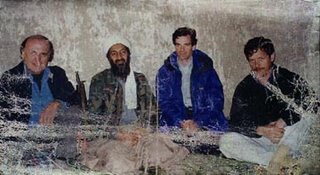
LEFT TO RIGHT PETER ARNETT 1997 CNN REPORTER, OSAMA BIN LADEN, PETER BERGEN CNN PRODUCER, SINCE WRITTEN BEST SELLING BOOK ON BIN LADEN, PETER JUVENAL CNN CAMERA MAN
John Holliman
Holliman joined CNN in 1980 as part of the network's original reporting team and was the first correspondent hired for the Washington, D.C., bureau.He was one of only three journalists reporting from Baghdad in January 1991 when the allied air attack began on Iraq's capital during the Gulf War. He and colleagues Peter Arnett and Bernard Shaw played critical roles in CNN's coverage of the crisis, which won a National Headliner Award, the George Foster Peabody Award and a Golden Microphone Award.
"When the bombing started, we immediately lost power, so we thought we wouldn't be able to broadcast," Peter Arnett said. "But then Holliman went to our equipment and just switched out the batteries, and we were able to communicate for several days like that with the hounds of hell falling on our heads."
"He's the one who made that first broadcast possible. He had a real knowledge of broadcasting," Arnett said.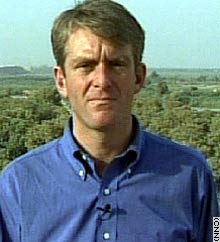 Nic Robertson
Nic Robertson
His first role on joining the network in January 1990 was as an engineer, and during the 1991 Gulf War, he was the only CNN engineer in Baghdad. He was also responsible for the first live satellite links out of Iran, Ethiopia and Iraq. His knowledge of technology has been beneficial both as a producer and a reporter. In the remotest of regions without electricity and telephones, such as Afghanistan, he has been able to file reports via the latest in technological advancements such as TOKO receivers and digital videophones.
Based in the network's Chicago bureau from 1991-1993, Robertson was producer for CNN's award-winning Bosnian War team from 1992-1995 and was also part of CNN's Emmy Award-winning team for the live coverage from the shores of Mogadishu, Somalia, as the U.S. troops launched operation Restore Hope in 1992. In 2002, Robertson won an Alfred I. duPont-Columbia Award for his reporting for the 2001 CNN Presents' "Northern Ireland: Dying for Peace" documentary.
In 2003, Robertson reported live from Baghdad until officials expelled the CNN group just hours before the coalition bombed the city. Robertson taped the bombings as they were fleeing and that footage later aired on CNN as an exclusive. After leaving Baghdad, Robertson reported from Jordan, often offering insight into the latest reports coming from Baghdad. He later returned to Baghdad to report on the latter stages of coalition movement into the city.
Eason Jordan 
Jordan worked for 23 years with CNN, where he rose through the ranks to become the network's Chief News Executive and President of Newsgathering and International Networks. Jordan oversaw CNN's news coverage, global expansion, and international relations. He orchestrated CNN's award-winning reporting of the wars in Iraq, Afghanistan, former Yugoslavia, and Somalia. He also directed CNN's coverage of the September 11, 2001 terrorist attacks, the collapse of the Soviet Union, and the 1989 crackdown in Tiananmen Square. After two of his CNN colleagues were killed by insurgents in Iraq in 2004, Jordan co-founded and co-chaired the Iraq News Safety Group, and on behalf of the Group met senior U.S.and Iraqi officials to address the safety concerns of news organizations whose journalists report from Iraq. CNN News Group President Jim Walton said that under Jordan's leadership, the news group "literally circled the globe with bureaus, from Baghdad to Johannesburg to Havana to Sydney to Hong Kong." 10 of his CNN colleagues were killed in Iraq and Somalia. Jordan felt a top-notch news and safety tip service produced for employers and their employees in war zones would empower those at risk to make more enlightened judgments about their movements and actions—perhaps saving lives. "The regard in which he is held by people from every walk of life in virtually every corner of the world has added incalculably to our ability to cover such historic events as the Gulf War and the war in Iraq, the collapse of communism in Eastern Europe, the crackdown in Tiananmen Square and the attacks on the World Trade Center and the Pentagon," Walton said in a written statement to colleagues.
CNN News Group President Jim Walton said that under Jordan's leadership, the news group "literally circled the globe with bureaus, from Baghdad to Johannesburg to Havana to Sydney to Hong Kong." 10 of his CNN colleagues were killed in Iraq and Somalia. Jordan felt a top-notch news and safety tip service produced for employers and their employees in war zones would empower those at risk to make more enlightened judgments about their movements and actions—perhaps saving lives. "The regard in which he is held by people from every walk of life in virtually every corner of the world has added incalculably to our ability to cover such historic events as the Gulf War and the war in Iraq, the collapse of communism in Eastern Europe, the crackdown in Tiananmen Square and the attacks on the World Trade Center and the Pentagon," Walton said in a written statement to colleagues.
He resigned to CNN due to a controversy that exploded after his remarks about the deaths of journalists in Iraq threatened to tarnish the network he helped build. Several participants said he told the audience that U.S. forces had deliberately targeted some journalists. The Center to Protect Journalist has stated that journalist are indeed target of the USA forces in Iraq. For more information: HERE
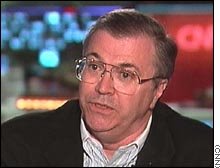
Tom Johnson joined CNN as president on August 1, 1990 -- one day before Iraq invaded Kuwait. In 1998, during Johnson's tenure as chairman, a Wall Street Journal/NBC national poll named CNN the "most trusted" news organization. "Tom presided over a dramatic expansion of CNN's newsgathering operations and led the network into the age of digital interactivity," said Gerald Levin, chief executive officer at AOL Time Warner. "Throughout his tenure, he's upheld and enhanced the traditions of journalistic integrity and independence that distinguish CNN as the world's foremost news brand
Ed Turner 1936-2002
"He regarded everyone who picked up a camera, who edited a piece, who ran an assignment desk, who cut a package, who sound-teched with equal regard," said John Zarrella, CNN's Miami bureau chief. "Everyone was part of the process and without everyone ... that fell apart."
Ted Turner hired Ed -- no relation -- and a small group of other news professionals in 1980 to make around-the-clock television news an engaging and profitable reality. Ed Turner remained at CNN until 1998, when he left his position as vice president in charge of newsgathering.
"It was a crusade, absolutely," Ed Turner once told a magazine at his alma mater, the University of Oklahoma, regarding the network's early days. "No one knew whether it would work, but the challenge was too great not to have a go at it."
Turner's innovative approach helped CNN invent itself in the '80s and '90s, as he sent hundreds of journalists around the world. Under his leadership, the network broadcast countless live events, including the billiard room rape case in New Bedford, Massachusetts, the Claus von Bulow trial and the Solidarity uprising in Poland.
"You can almost reach out and touch Ed Turner's impact on CNN," said Bernard Shaw, an original CNN anchor. "His standards were so high. The things that this network does routinely and the kinds of people that work for CNN ... are a testament to what Ed Turner stood for."
"More than anything, Ed will be remembered as the newsman's newsman," said former CNN News Group chairman and CEO Tom Johnson. "He could be so tough on his people in his pursuit of getting it right and getting it first, but he could also be a wonderful teacher."
Iraqui former minister of Information and alleged CIA mole that gave the USA assurance of the existence of Weapons of Mass Destruction... we know how that ended.





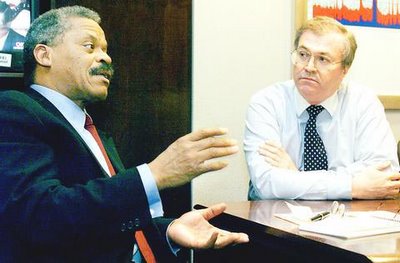

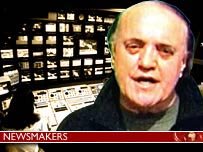










6 comentarios:
That's an amazing amount of information and very interesting too. Thanks for a wonderful history lesson.
@christiane -- very interesting, as usual. Thanks for putting all of this in a perspective, a great insight for those of us who wasn't watching 24 hour news 15 -20 years ago nand just heard of those broadcasts and newspeople.
Is that young Nic Robertson on a collage?? -) Hmmmm -) I think I want to see some more - lol
This post is quite thought provoking. Does it seem to you that new technology in the news industry has a good side and bad one? Just as any technology? It does make a lot more broadcasts possible and helps deliver information instantly from a lot more places. At the same time that availibilty and stream of information seems to distract news providers from the big picture, leads to lack of focus and therefore lack of thoroughness. Not the last factor here might be a bigger competition between news channels (there are more of them now then 15 years ago) which again could be a good thing but also could be distractive from creative thinking.
Thanks Phebe by stopping by! I really appreciate it. Keep the good work at ATA!
What a fascinating time in CNN's history to be live from Baghdad. They totally owned that story the moment Weiner hit the streets. Most impressive.
Weiner is a legend and he wrote a great book. The movie, well it was Hollywood after all, but it was still pretty truthful.
Tom Johnson was recently fired from his post as editor at the Los Angeles Times, for not cutting his newsroom staff. Good for him.
Great post!
Post a Comment